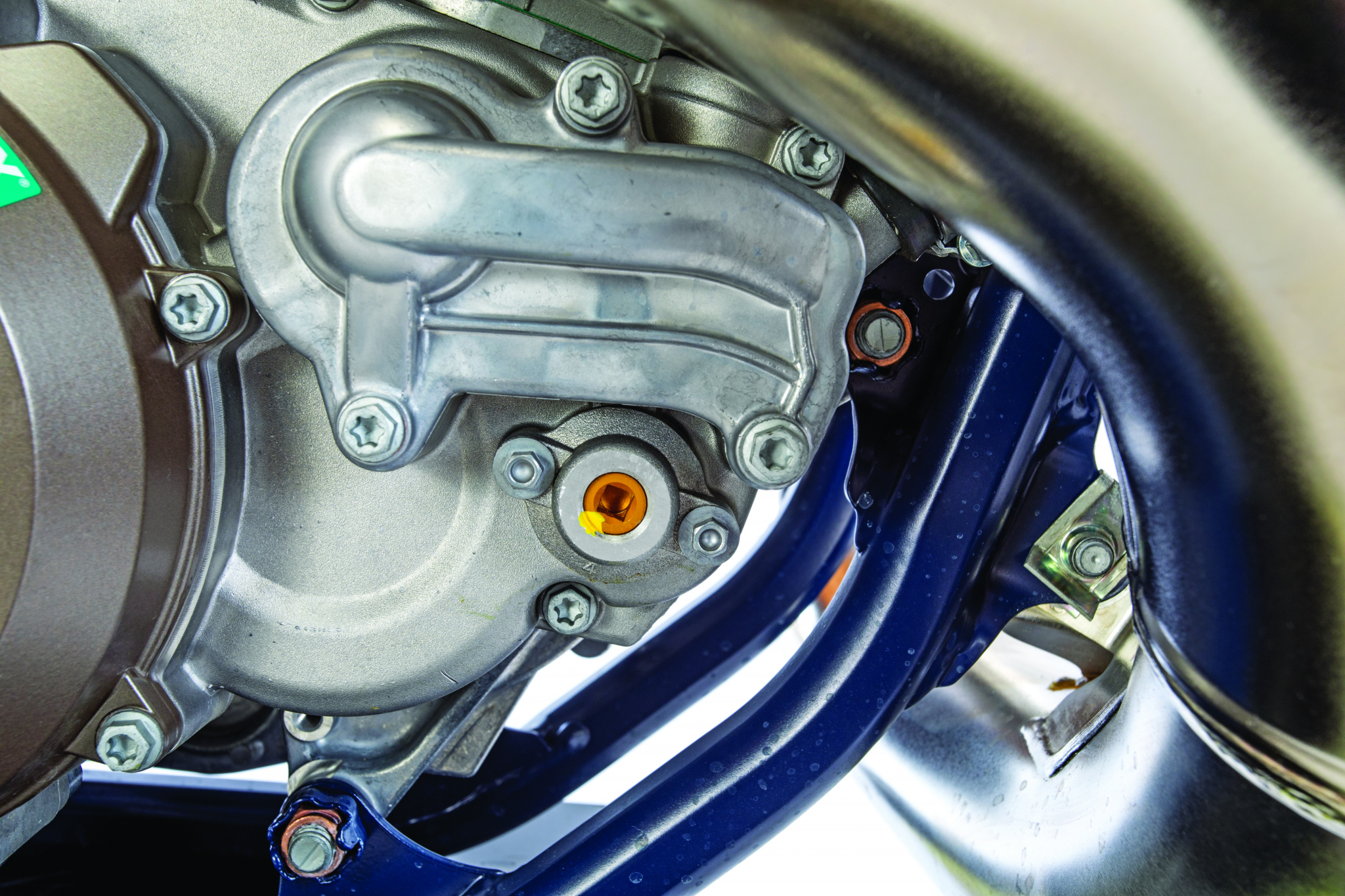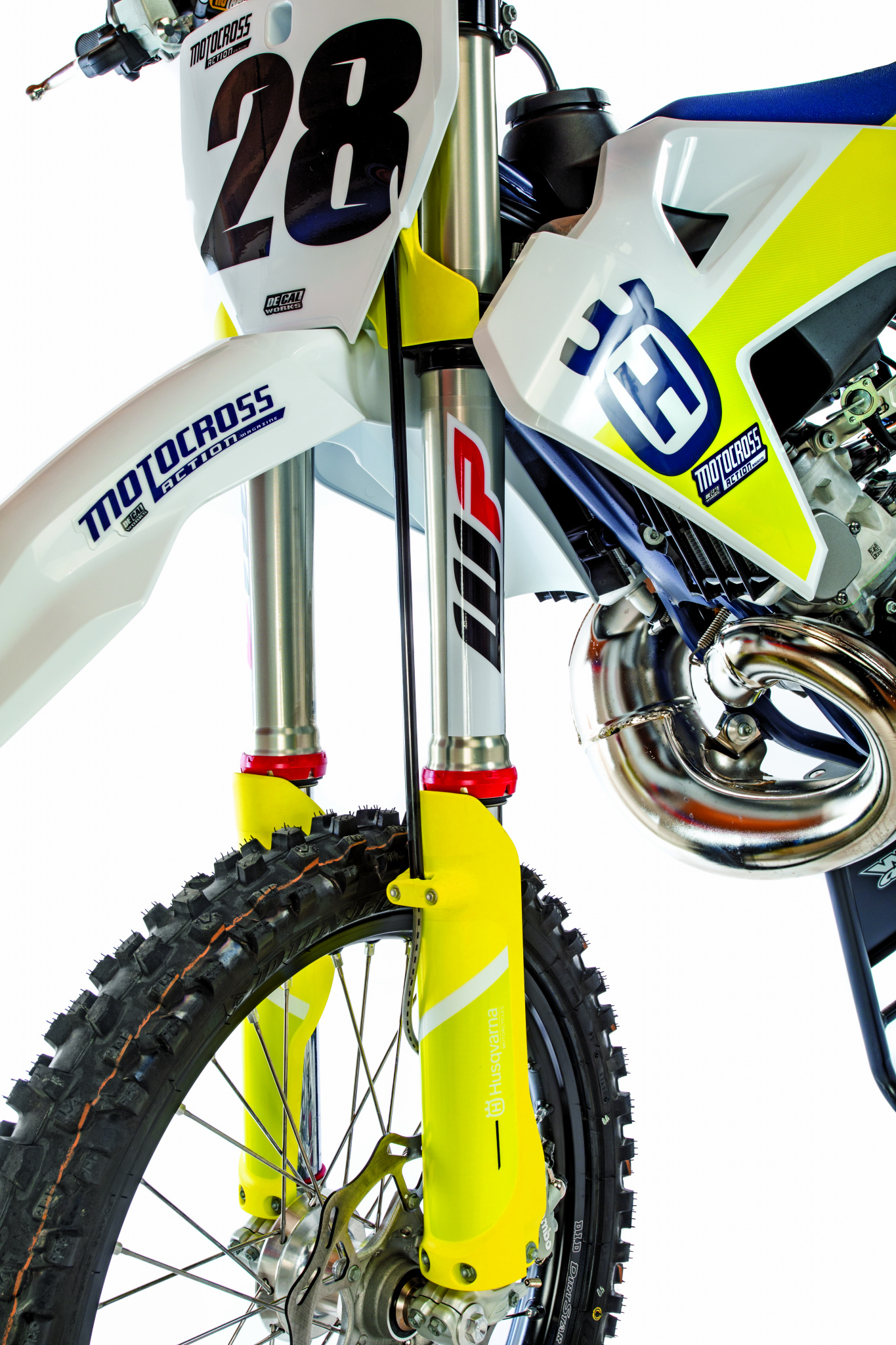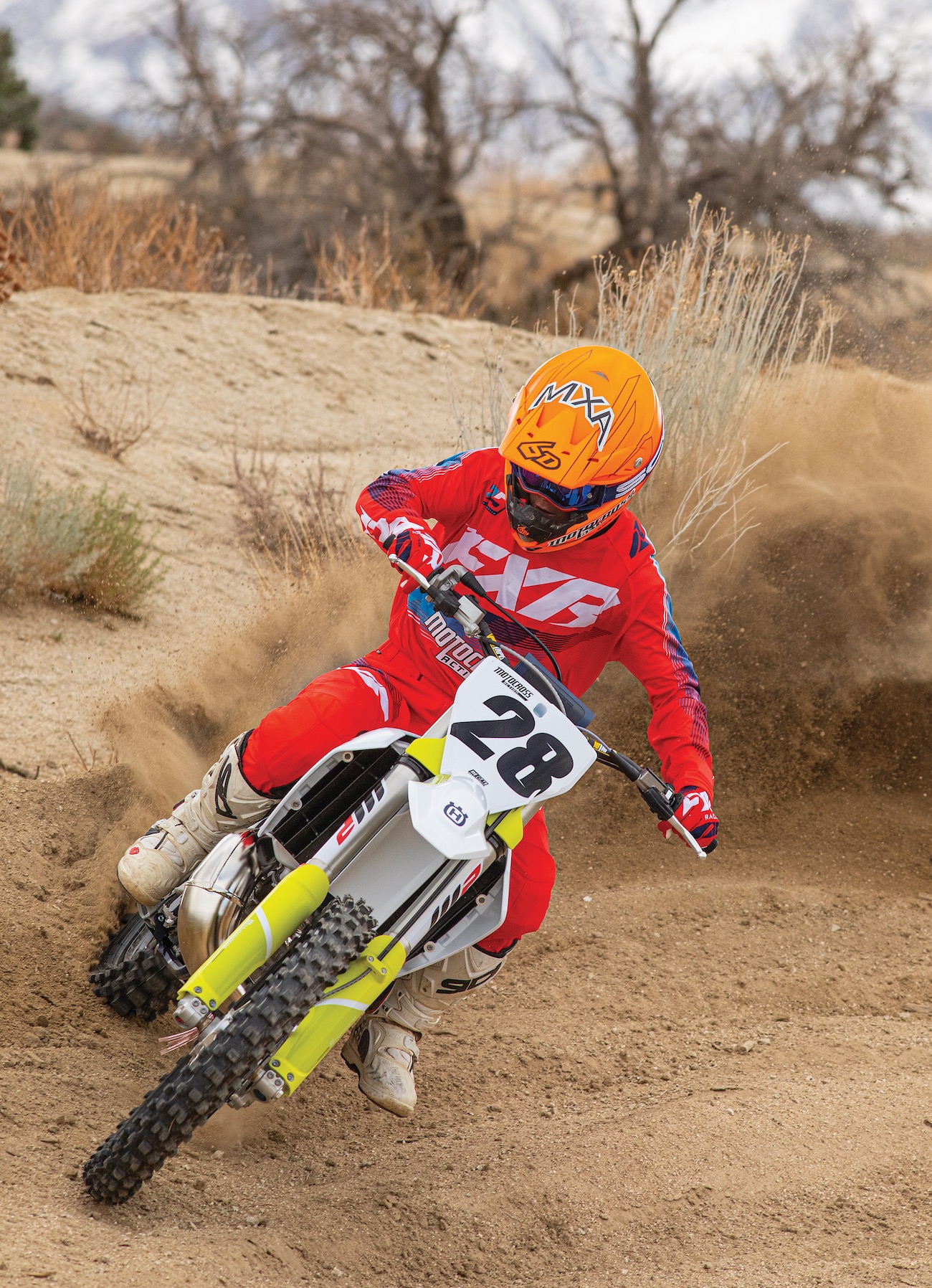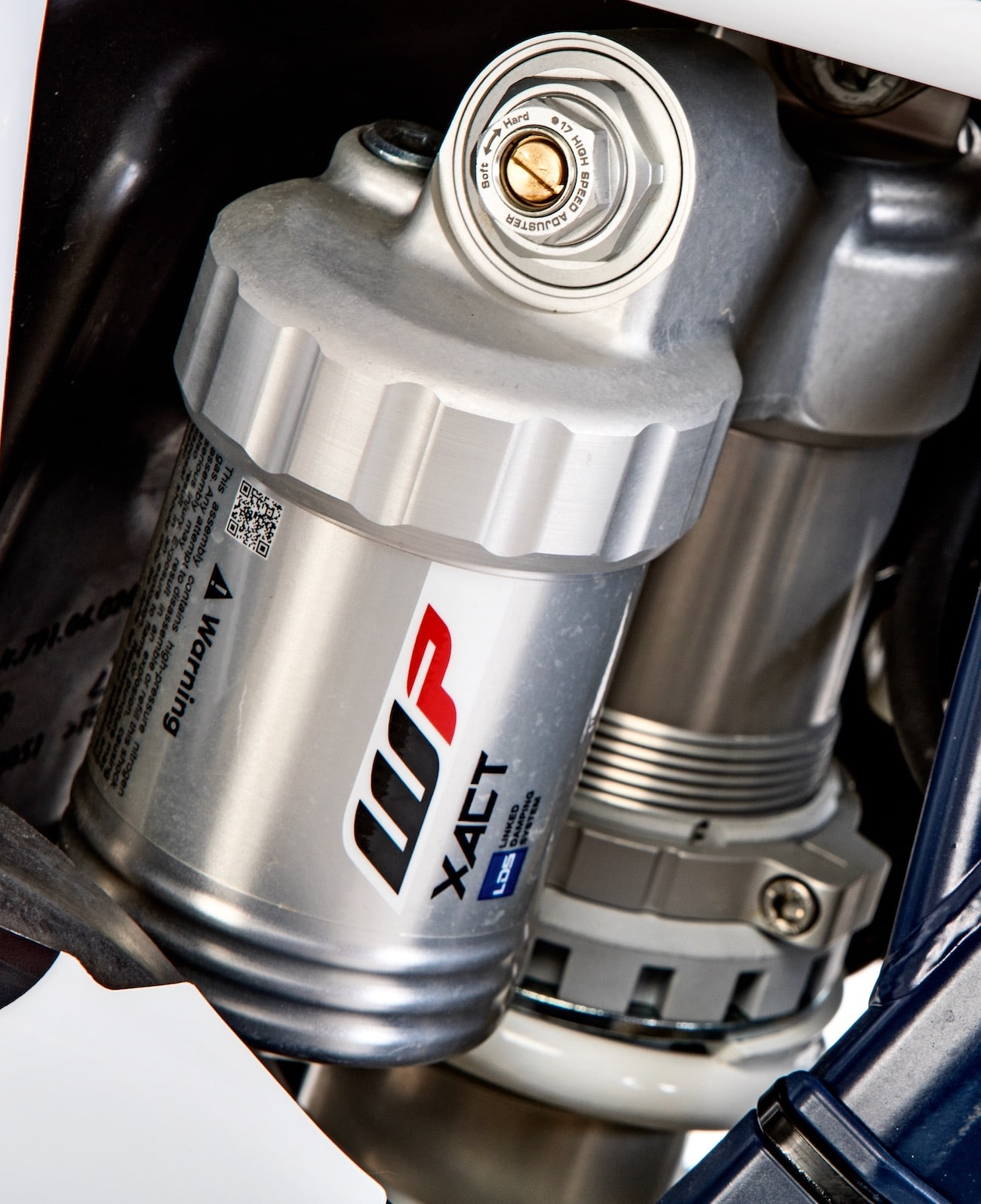MXA RACE TEST: THE REAL TEST OF THE 2021 HUSQVARNA TC250 TWO-STROKE

Q: FIRST AND FOREMOST, IS THE 2021 TC250 BETTER THAN THE 2020 TC250?
A: Yes, by far. The 2021 Husqvarna TC250 is better for the same reasons all of the 2021 Husqvarna models have improved this year. Plus, the TC250 benefited further from a few additional upgrades that the four-stroke line didn’t get.
Q: WHAT’S NEW ON THE 2021 HUSQVARNA TC250?
A: The list is small but mighty. The major upgrades are to the fork internals and the overall height of the bike.
(1) Lower height. As with the rest of the Husqvarna big bike line, the overall height of the TC250 has been lowered for 2021, and we love it. The linkage arms were extended, and the bell crank was updated. This brought the rear end down and the rising-rate back to the same setting as the KTM 250SX. Then, to prevent the rear tire from hitting the fender (which was now closer) the seal head on the WP shock was made 6mm longer, limiting travel from 140mm to 134mm. Then, to balance it out, the WP forks were made 10mm shorter at both the cartridge rod and stanchion tubes, keeping the same relationship between the two, except now with a lower ride height and 10mm-shorter travel.
(2) Fork updates. As with all of the 2021 Husqvarna, KTM and GasGas models, the TC250 received all-new internals with improved oil bypass notches, a new air seal with extra air bypass holes, and an enlarged crossover bleed slot to help air move from the positive to the negative air chambers easier. There is a new bump stop rubber and an adjust-by-hand rebound clicker. Plus, on the Husky two-strokes and FX models, WP replaced the ingenious trampoline valve with a new float setting shim at the mid-valve (not found on motocross forks). All of these updates result in a fork that compresses easier and is more predictable to ride with.
(3) Throttle. The Husky TC250 received a Gunnar Gasser-style roller-actuated throttle to improve throttle feel and extend cable life.
(4) Tires. Dunlop MX33 tires replaced the MX3S.
(5) Seat cover. The TC250 got a new seat cover that’s softer (without the diamond sandpaper-like traction material) to increase comfort.
(6) BNG. The graphics are better, but the bike has the less-than-attractive Husqvarna Vitpilen street-bike-inspired number plates with a massive gap between the top and bottom of the plates.
Q: HOW DOES IT RUN ON THE TRACK?
A: The power hits hard. Since all of the updates were chassis-related, the 2021 Husqvarna TC250 engine still has the same personality it had last year. To understand its strengths and weaknesses, we like to compare it to the KTM 250SX and Yamaha YZ250. As usual, the Husqvarna tucks in behind the KTM when it comes to power delivery. The shape of the KTM’s aluminum subframe, KTM airbox design and airbox cover allows air to flow easily into the KTM engine, giving it more snap off the bottom and an overall stronger pull. The Husky has a similar feel, but it’s toned down a notch (largely because of the molded plastic/carbon matrix airbox/subframe combo). As for the Husky versus Yamaha YZ250 battle, the power is a complete contrast. Yamaha’s power is focused in the mid-to-high rpm range, while the Husky is all bottom-to-mid. The Yamaha likes to rev out further, as it picks up farther down the straight while the Husky needs to be shifted much more often. The Husky TC250 got the same new WP XACT forks and lower overall seat height as its four-stroke brothers.
The Husky TC250 got the same new WP XACT forks and lower overall seat height as its four-stroke brothers.
Q: DID WE ADJUST THE POWERBAND?
A: Although the TC250 was fun to ride in stock trim, we wanted to do some adjusting. Luckily, Husqvarna offers two tuning options that don’t cost a penny and another one that’s also free if you have a ’20–’21 model Husqvarna four-stroke nearby. We worked to figure out which settings were best for Novice-, Intermediate- and Pro-level riders.
(1) Airbox cover. Since the Husqvarna two-strokes don’t come with the optional ventilated airbox cover, like the Husqvarna four-stroke, we took the vented airbox cover from our FC450 and gave it a try. Even though the Husky vents are minuscule and located in a less than ideal position, they still increased air flow and made the TC250 noticeably better at the snap of the throttle. Our faster testers wanted the vents and snappy throttle, but our slower testers didn’t want the extra responsibility of handling more bottom-end power. The vented cover is available at your Husky dealer. Or, better yet, drill 1-1/4-inch holes into your stock cover to help it out even more.

(2) Power valve. The Husqvarna power valve is a movable flap located in the cylinder’s exhaust port where burnt gases are flushed out of the cylinder. Turning the power valve’s screw clockwise preloads a spring that holds the exhaust port closed for longer. Turning the power valve screw counterclockwise allows the exhaust port to open quicker, creating a more aggressive hit. As a rule of thumb, we instantly remove the stock adjuster, which requires a square Robertson wrench head screw to activate, and replace it with a Kreft Power Dial 2.0. It’s faster for us to install a Kreft adjustable Power Dial than it would be to walk the pits looking for the correct tool. Plus, with the Kreft Power Dial, we can make quick adjustments on the track. Our Pro-level test riders liked the instantaneous power of the bottom end with the Power Dial turned all the way out whenever the track had good traction. But, the majority of test riders turned it 1-1/2 turns in from all the way out to maintain a more controllable power. Vets and less-skilled riders went even further in to tame the power.
(3) Mapping. The dual map switch worked a lot like the power valve. Map one is aggressive; it wanted to get up and go right away. Map 2, the one with the two hash marks, is mellow. It allows the power to roll on slightly slower and helps increase traction coming out of corners. We bounced back and forth between the two depending on the conditions of the track, but the more comfortable our testers got, the more we found them using the aggressive Map 1.

Q: WHAT’S UP WITH THE HUSKY MAP SWITCH?
A: It’s odd. Have you ever wondered why Husqvarna consistently charges just a little more than KTM? The Pierre Mobility group (owner of all three KTM brands) sees the Husky lineup as a premier brand and the KTM lineup as ready-to-race. The map switch is a great example of the two philosophies played out. KTM has two maps, but to access them you have to find the wire that hangs down near the petcock and either plug it in to get the aggressive map or unplug it for the mellow map. Husqvarna uses the old-style, click-type, handlebar-mounted map switch from its Power Parts catalog to offer something extra for your money. We appreciate that it’s there but hate the design of the switch. It’s confusing to know which map you’re in, impossible to change on the fly, and still a challenge to change even if you’re standing in the pits.
Q: DOES THE 2021 TC250 HAVE THE SAME SUSPENSION SETTINGS AS THE FOUR-STROKES?
A: Nope. Although WP is in charge of the suspension components and settings for all KTM, Husqvarna and GasGas bikes, WP doesn’t have a one-size-fits-all setting. The goal is to start with a base setting for each brand and then tailor the spring rates, recommended air pressure and valving to specifically suit each bike. Traditionally, the Husqvarna (and KTM) two-strokes ride higher in the suspension’s stroke than the four-strokes because they weigh less, have less rotating mass in the engine and have a harder hitting powerband and minimal engine braking.
Four-strokes weigh more, have a smoother power delivery, more rotating mass and more engine braking; each of these factors causes four-strokes to ride lower.
In contrast, the Husqvarna TC250’s two-stroke power needs softer forks and a stiffer shock. The lighter weight and absence of engine braking mean that there’s less weight on the forks when you’re on the brakes coming into a corner. And, the hard hit of the Husky two-stroke engine throws more weight backward, requiring a stiffer shock to compensate. With its unique inertia, the TC250 has a plusher (dare we say off-road) suspension feeling when compared to four-strokes.
Q: WHAT’S UP WITH THE NEW FLOAT SETTING ON THE WP XACT TC250 FORKS?
A: You might be surprised to know that Husqvarna’s two-stroke line didn’t have a mid-valve shim stack for damping the front forks prior to the 2021 model line. All of the damping was conducted at the base valve only.
Prior to 2021, WP technicians had issues with breaking shims at the mid-valve on their two-strokes and cross-country models. Why? Well, they wanted softer forks, and that meant using lighter shims to dampen the movement of the fork leg as it compressed. Thinner shims allow oil to pass by easier, while thicker shims resist oil flow and create stiffer suspension. The shims they originally wanted to use would bend or break because they were too flimsy. New for 2021, the mid-valve shims are back, and they’re utilizing a new “float setting” component to do it.
The float setting works a lot like the trampoline shim on the new four-stroke forks. The trampoline shim has a small cavity underneath it that allows the shim to bend down and offer more damping without getting stiffer at the end of the stroke. The float setting works the same, only it has a light spring inside the cavity that pushes the shim back up. Basically, it’s just making sure the trampoline shim doesn’t break. With this little spring, WP is able to meet its durability standards and create a plush two-stroke setting for the forks without breaking shims.
Q: HOW GOOD ARE THE NEW WP XACT AIR FORKS IN MOTION?
A: Really good. We already knew they were better since we’ve tested all of the Austrian four-strokes, but, surprisingly, it feels like the TC250 forks made the biggest leap forward of them all. Our test riders’ first impression of the XACT air forks was extremely positive. They were in love after the first date. The lowered overall height (and therefore center of gravity) of the bike made getting into corners much easier. Then, when the power hit, the front end would stay in the rut without trying to hop out. Typically, the strong torque of the TC250 requires some extra effort to keep the front wheel from climbing out of ruts. Not so with the new forks.
Our testers felt confident through the rough stuff and praised WP for its new bypass and bleed technology inside of the forks. On the outside, the forks look exactly the same, but on the inside they’re full of new oil and air bleed holes along with bypass notches that reduce pressure peaks to create plusher and more predictable fork action that follows the ground with ease. The new WP forks have improved immensely.
Q: HOW DO YOU FIND THE CORRECT AIR FORK SETTINGS?
A: As always, we set our air-pressure settings based on data and not our egos. The typical jock mindset says, “If stock is 10.4 bar (150 psi), I need at least 11.0 bar (159 psi).” Riders think that because they are fast, they need more air. They also think air pressure in the forks is like a super-secret custom Yamaha Power Tuner map setting; if a certain air pressure works for one rider, it’s gotta work for you, right? Wrong. The air pressure is the spring rate of your forks. Unless you’re riding Supercross, you need to choose your spring rate based on your weight, not speed. How do you find it? Set the pressure to the recommended setting (and if you don’t know it, there is a sticker in the fork stanchions that tells you the standard air pressure and clicker settings for every 2021 Husky model). Once you have the pressure set, wrap a zip-tie around your fork leg. Monitor where it sits after a few laps and then increase or decrease air pressure until the zip-tie lands at 1-1/2 inches from bottoming out. Then, use the compression, rebound and fork height to fine tune the setting you like.
The stock TC250 recommendations are 10.4 bar (150 psi), 12 clicks out on compression, 18 clicks out on rebound and the fork height on the second line. The majority of our testers kept the air pressure and clickers in their stock positions. Our slower testers liked going softer on the clickers with 16 clicks out on compression and 20 clicks out on rebound to speed it up.
Q: HOW IS THE WP SHOCK?
A: Besides the longer link arms, updated bell crank and the 6mm-longer seal head, the rear shock system also got two more upgrades. It got low-friction SKF seals in the linkage and a new Viton O-ring behind the shock piston bushing for increased durability.
The WP shock handled great. We’re asked questions about the shorter suspension travel, especially by taller riders who haven’t tried the new Husqvarnas yet. To be honest, the 6mm-shorter shock and 10mm-shorter fork travel isn’t noticed in a negative way. The rear of the chassis is considerably lower, while the forks can be brought down by sliding them up in the clamps. We love the lower suspension and don’t feel like we’re limited on suspension travel. Plus, the rider is not cramped on the Husky or stretched out on the KTM, because the rider triangle (handlebars, foot pegs, seat) is exactly the same.
Across the board, our test riders loved the new, shorter WP shock. We set the sag at 105mm for each test rider, stuck with the stock clicker settings and got zero complaints. The TC250 tracks through corners better than ever, and it didn’t give up comfort anywhere else.
Q: WHAT DID WE HATE?
A: The hate list:
(1) Airbox cover. We wish it came with the same vented airbox cover option as the FC models (we like having the option); however, the Husky airbox cover needs a handle (like the KTM has) for removing it. The tool-free airbox cover can be installed and removed by hand, but we usually stick a T-handle behind the panel to pop it off easier.
(2) Map switch. It’s cool to have it on there, but it’s frustrating to use because it is hidden under the throttle cables and housing.
(3) Frame color. White was so much better.
(4) Spokes. As always, the spoke next to the rim lock comes loose quickly, especially when breaking your bike in. Check it each time you ride.
(5) Number plates. Husqvarna wants to be different, and it has achieved that. Can we go back to normal one-piece number panels now?
Q: WHAT DID WE LIKE?
A: The like list:
(1) Weight. At 211 pounds, everything about the TC250 is light, especially the air forks.
(2) Throttle. The new roller-actuated throttle pulley seems cool. We didn’t have any issues with the pull or durability last year, but we appreciate that Husqvarna is making upgrades to its two-strokes.
(3) Suspension. MXA has asked for lower motocross bikes for years. Husqvarna finally did it in 2021, and it has been a huge success.
(4) Clickers. We appreciate that you can turn the fork’s compression and now rebound clickers by hand.
(5) Gearing. MXA asked for the 14/49 gear ratio in 2019, and it is now the stock gearing on the 2020 and 2021 models.
(6) Brakes. The Brembo brakes are second to none.
(7) Handlebars. Many of our test riders preferred the 10mm-wider Husqvarna Pro Taper handlebars over the non-branded Neken KTM handlebars.
(8) Price. The TC250 goes for $8499. That is $1800 less than a Husky FC450 four-stroke, $1000 more than the Yamaha YZ250 and $100 more than the KTM 250SX.
Q: WHAT DID WE REALLY THINK?
A: The MXA wrecking crew has a major soft spot for two-strokes, and we were very happy to see Husqvarna implement its lower-overall-height platform on its two-stroke line. The Husqvarna TC250 has an exciting powerband with an exceptional chassis that provides superb handling. We absolutely love the lowered suspension on the FC250, FC350 and FC450, but we appreciate it even more on the TC250 two-stroke.

MXA’S 2021 HUSQVARNA TC250 TWO-STROKE SETUP SPECS
This is how we set-up MXA’s Husqvarna TC250 for week in and week out racing.
MXA’S 2021 HUSQVARNA TC250 FORK SETTINGS
Use the zip-tie method to find your correct spring rate (aka air-pressure setting). Then, once you find the air-pressure number that brings your forks to within 1-1/2 inches of bottoming out, start messing with the compression clicker until you’re comfortable. For hardcore racing, we recommend this fork setup for the 2021 Husqvarna TC250.
Air pressure: 10.4 bar (150 psi)
Compression: 12 clicks out (for Intermediate and up), 16 clicks out (for slower or lighter riders)
Rebound: 12 clicks out (14 clicks out for slower or lighter riders)
Fork height: 2nd line
Notes: As a rule of thumb, don’t start playing with your air pressure or clicker settings until you set the sag, check the tire pressure and bleed the air out of the little Torx head bolt on both forks. Also, check your forks’ air pressure as often as you check your tire pressure throughout the day. We’re confident that you’ll love the new WP XACT suspension, but you have to make sure to do proper maintenance.
MXA’S 2021 HUSQVARNA TC250 SHOCK SETTINGS
Husqvarna and WP hit the nail on the head with their TC250 suspension settings, and the comfort we found in the WP shock proves that. For hardcore racing, we recommend this shock setup for the 2021 Husqvarna TC250 (stock specs are in parentheses):
Spring rate: 42 N/mm
Hi-compression: 1-1/2 turns out
Lo-compression: 15 clicks out
Rebound: 15 clicks out
Race sag: 105mm
Notes: Our testers have had almost no complaints about the WP XACT shock on all of the new Husqvarna models across the board.
MXA’S 2021 HUSQVARNA TC250 JETTING SPECS
There were struggles when Husky switched from the Keihin PWK carb to the 38mm Mikuni TMX carb in 2017, but the next year it got better, and for the last three years we’ve been happy with the stock jetting. Obviously, there will be some air screw, needle or pilot adjustments needed for your local elevation, humidity and temperature. Here’s what we ran in our Mikuni TMX carb:
Main jet: 450
Pilot: 35
Needle: 6BFY42-71
Clip: 3rd
Air screw: 1-1/2 turns out
Notes: If the bike is hesitant off the bottom end, try adjusting the air screw. Have someone hold the throttle at 1800 rpm while you turn the air screw in and out. When the engine’s idle reaches its highest peak rpm, that is where the air screw should be.










Comments are closed.